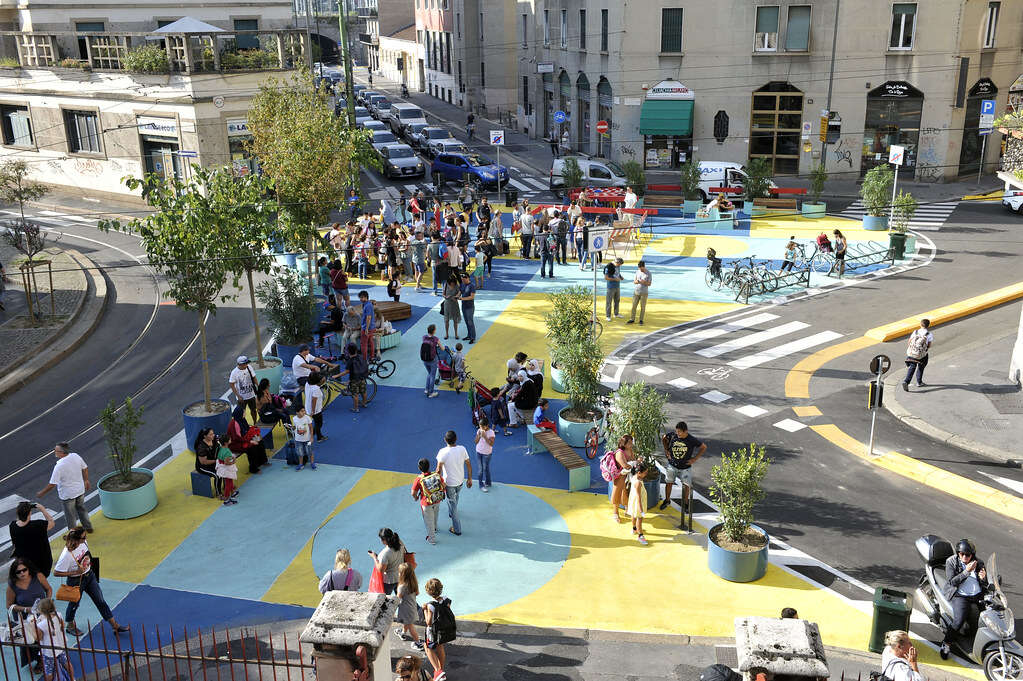
Play is essential for children’s well-being and happiness, as well as for their healthy physical and emotional growth. A well-designed built environment can provide spaces in cities for children to realise the potential of playful learning experiences.

But during the global pandemic, possibilities for play, education and social interaction among children and young people were severely limited. In recent years, in many cities, pressure on available space has seen fewer playgrounds being built, and we are also actually seeing a gradual erosion of shared play spaces. For example, in England alone, 250 school playing fields were disposed of between 2010 and 2021. And we need to design neighbourhoods that encourage play beyond playgrounds, considering all of the environments in which children spend their time, including public spaces.
As cities rebuild post-lockdowns, they must tackle this ‘silent emergency’, and restore and create new opportunities for play as a central part of their planning. This will help not just children, but also improve cities for all their citizens; less pollution, more green spaces, and the freedom to move about easily and safely are aspirations shared by city leaders and children alike.
Yet there is not enough guidance available to help cities design neighbourhoods to encourage play. That’s why Arup developed the Playful Cities Toolkit, in partnership with the LEGO Foundation and the Real Play Coalition. The practical guide provides resources for local governments, urban practitioners and local communities to understand the complexity of play in cities and to guide the design of play-based interventions.
Promote access to facilities for children
In urban decision-making and planning, the needs and challenges of children often go unheard. That means we are left with cities that are unequipped to support children through development.
Busy traffic has pushed children from the streets in which they used to play, pavements have become busier and narrower, and children’s independent mobility has seen a continuous reduction.
[Read more: Why swings are disappearing from UK playgrounds]
Rather than creating environments where children might thrive, many initiatives have focused on acting as mitigating measures. Essentially, helping children to develop the skills required to survive in dangerous traffic-dominated environments rather than addressing the fundamental issues with the environment.
To help solve the problem, the focus needs to shift from the removal of children from danger to removing danger from the environment. These ideas can be seen in action in San Francisco’s Play Streets SF programme, which helped residents transform their block into an open, accessible, and car-free space for children and seniors, through assistance on practicalities from permits to safety equipment and games.
Invest in green space and a clean environment
Global urbanisation trends are reducing accessible open space for play, as urban landscapes often compromise green, blue and brown spaces as cities expand and fill. But these things don’t have to be mutually exclusive. In China, for example, Hangzhou City’s master plan promotes green space within rapidly urbanising environments.
The benefits of urban green space are broad and are especially important for children. Young people’s physical and mental development is greatly enhanced by living, playing and learning in green environments.
Cities should therefore aim to enhance a child’s connection to nature by investing in more green and healthy environments that offer children considerable play value. Green play areas can be embedded in the way we design and plan for public space, transforming the urban landscape into a learning opportunity and turning polluted and unsafe sites into vibrant assets.
Provide opportunities for social interaction
With less independent mobility, children cannot independently navigate and experience urban landscapes, resulting in fewer opportunities for social interaction, chance encounters, playful journeys and discovery.
Social interaction in play allows children to collaborate, communicate their thoughts and feelings, and understand other perspectives as they develop their social skills. By putting this at the centre of our environments, cities can help encourage the interactions necessary for children to practice the relational skills that enable our communities and society to be adaptable and sustainable.
[Read more: How children at urban schools can benefit from learning in nature]
Thinking about how play can be supported in cities can therefore help bring together communities by creating an intergenerational and multifunctional public realm that families and communities can enjoy together. For example, across Asia, the UN-Habitat, with the Block by Block Foundation, has helped a number of cities to enhance public spaces, which has allowed these communities to regain confidence in being together and using public spaces safely.
How to move forward with Children’s play
As well as being areas for children’s play, greater access to shared spaces can have a positive effect on communities as a whole. This is because outdoor play and interaction generate numerous benefits for communities and cities, as play spaces frequently become community hubs where people can engage with each other.
Play is also associated with other community benefits such as higher levels of volunteering and community action; improved social cohesion between different ethnic groups; and a reduced incidence of anti-social behaviour and vandalism.
It’s important that city planners and governments understand that designing child-friendly cities is more than just building more playgrounds – encouraging play must infuse all urban systems and occur at all levels of society. The Playful Cities Toolkit will help people understand the fundamental importance, not just of independence and play, but of the built environment as a whole in helping to shape a child’s development and prospects, and hence their adult lives.






